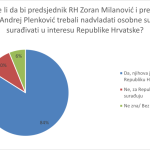ZAGREB, October 9, 2018 – The International Monetary Fund (IMF) expects Croatia’s growth to rise by 2.8% in 2018 and to decelerate at the rate of 2.6% in 2019, according to the latest issue of the World Economic Outlook.
Thus, IMF forecasts for Croatia’s economic growth in 2018 and 2019 remained unchanged in comparison to the previous Outlook issued in April. However, the country’s inflation rate is expected to be 1.6% as against the previous forecast of 1.5%. In 2019, the inflation rate is likely to be 1.5%.
Croatia’s unemployment rate is to fall from 12.4% in 2017 to 12% in 2018 and further down to 11.2% in 2019. The publication also notes that Croatia’s current account balance surplus could slide from 3.9% of GDP in 2017 to 2.7% of GDP in 2018 and to 2.3% of GDP in 2019.
The Fund’s forecasts for Croatia’s economy are mainly in accordance with the projections of other analysts.
Thus projections for Croatia’s growth in 2018 range between 2.3% as envisaged by Raiffeisenbank Austria (RBA) and 2.6% as projected by the European Commission to 3%, as forecast by Addiko Bank and the Institute of Economics in Zagreb.
The government in Zagreb has based the budget planning for this year on the projected growth of 2.9%,
In the first quarter of 2018, growth stood at +2.5% compared to the corresponding quarter in 2017, and accelerated to 2.9% in Q2.
In its latest Outlook, the IMF has revised down its projections for the global economy from 3.9% as predicted in April to 3.7%. “The steady expansion under way since mid-2016 continues, with global growth for 2018–19 projected to remain at its 2017 level. At the same time, however, the expansion has become less balanced and may have peaked in some major economies. Downside risks to global growth have risen in the past six months and the potential for upside surprises has receded,” reads the document.
“Global growth is projected at 3.7 percent for 2018–19 – 0.2 percentage point lower for both years than forecast in April. In the United States, momentum is still strong as fiscal stimulus continues to increase, but the forecast for 2019 has been revised down due to recently announced trade measures, including the tariffs imposed on 200 billion dollars of US imports from China. Growth projections have been marked down for the euro area and the United Kingdom, following surprises that suppressed activity in early 2018. Among emerging market and developing economies, the growth prospects of many energy exporters have been lifted by higher oil prices, but growth was revised down for Argentina, Brazil, Iran, and Turkey, among others, reflecting country-specific factors, tighter financial conditions, geopolitical tensions, and higher oil import bills.
“China and a number of Asian economies are also projected to experience somewhat weaker growth in 2019 in the aftermath of the recently announced trade measures. Beyond the next couple of years, as output gaps close and monetary policy settings continue to normalize, growth in most advanced economies is expected to decline to potential rates – well below the averages reached before the global financial crisis of a decade ago,” reads the document.








